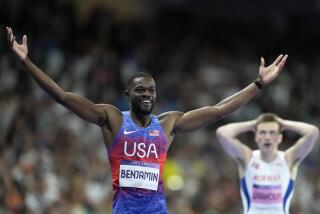U.S. Olympic trials took fast track to success
- Share via
EUGENE, Ore. -- Ups and downs of the U.S. Olympic track and field trials that ended Sunday:
Up: Eugene’s organizing committee. It turned the trials into a must-attend event, and that probably will carry over to the next running in 2012. Sellout crowds, a fan festival, bands, big screens next to Hayward Field, and an atmosphere better than any track meet -- including the Olympics -- I have attended in the United States.
Down: Eugene’s organizing committee, for inflating attendance beyond the capacity by counting everyone who wandered into the vicinity. Why exaggerate the truth when it was so impressive anyway?
Up: USA Track & Field for awarding the event to Eugene.
Down: USA Track & Field for kowtowing again to NBC schedulers and creating a competition program that allowed what should be a six-day meet to drag over eight (plus two rest days), making some days painfully bereft of action.
Up: Bernard Lagat. The only double winner (1,500 and 5,000 meters) in the trials is a tactical master, capable of controlling the field from the back (5,000) or the front (1,500).
Down: Alan Webb. After a 2007 season in which he posted the world-leading time in the 1,500, the former prep mile phenom now must contemplate comeback No. 2 in his checkered international career after finishing a non-contending fifth in the final.
Up: Every miler and distance runner who took risk by pushing his or her limits, including “Hey There” Delilah DiCrescenzo in the steeplechase, where she tried to be a factor before finishing last. (Deserved props, Delilah, after my snarling blog about your stiffing media after the race.)
Down: Athletes such as Torri Edwards, who dropped out of a final (the 200) because, according to a statement from her agent, she didn’t like her lane, or Galen Rupp and Josh Rohatinsky, who ran prelims of the 5,000 as a workout, with no intention of running the final. All deprived other athletes of places.
Up, Down, Up: Tyson Gay. He blitzed the 100, was injured in the 200, then accepted that misfortune with grace rather than rail against the unforgiving nature of the selection system.
Up, Up, Up: Lauryn Williams. The sprinter who rises to the occasion in big meets was as delightfully ebullient as always, whether losing a spot in the Olympic 200 by a hundredth of a second or winning one in the 100 by 3/100ths.
Down: Reigning Olympic and world champion Jeremy Wariner, reacting with disdain to questions about dumping longtime coach Clyde Hart for financial reasons, then losing the 400 meters, after which Hart told Sports Illustrated’s Tim Layden: “Sure, it hurts to watch what happened out there.”
Up: Fashion plate Sanya Richards, another of Hart’s athletes, reclaiming her star status after a year lost to illness. Wearing one of Nike’s half-Space Age (forearm covers), half-wonky (knee-high black socks) uniforms, Richards lighted up Hayward Field while winning the 400.
Down: Allyson Felix’s Q rating. Felix came out of last year’s world championships as the anointed one (see NBC commercials) among U.S. track women, but did little eye-catching at trials, winning the 200 (as expected) and finishing fifth in the 100.
Up: Walter Dix. Rejecting advice to turn pro last year in favor of earning his degree at Florida State, Dix became the only man to make the team in both sprints, winning the 200 and finishing second in the 100. (But now it’s time to get rid of that scuzzy FSU track suit.)
Down: Breaux Greer, the country’s best javelin thrower by a country mile for eight seasons and the reigning world bronze medalist, failing to get out of qualifying because his shoulder is such a mess.
Up: Jenn Stuczynski. A year after bursting onto the scene but getting injured and disappointing at the world championships, the pole vaulter confirmed she could jump high in championship meets. Nearly going out at her first height, Stuczynski rebounded to set a U.S. record.
Down: Stacy Dragila, 37. She set the pole vaulting standard after winning the first world (1999) and Olympic (2000) titles in the event, but the trials, where she finished tied for seventh, probably were her last major meet.
Up: Lori “Lolo” Jones. The 26-year-old high hurdler, queen of the indoor hurdles circuit, finally won a championship outdoors.
Down: Javelin thrower Bobby Smith, the only event winner at the trials who won’t go to Beijing because he had not met the qualifying standard.
Up: How everyone felt after the thrilling finish in the men’s 800, which became the highlight of the meet.
Down: How everyone will feel if any of the meet’s stars are found to have tested positive, sending the drug-battered sport to rock bottom.
--
Philip Hersh covers Olympic sports for The Times and the Chicago Tribune.
More to Read
Go beyond the scoreboard
Get the latest on L.A.'s teams in the daily Sports Report newsletter.
You may occasionally receive promotional content from the Los Angeles Times.






